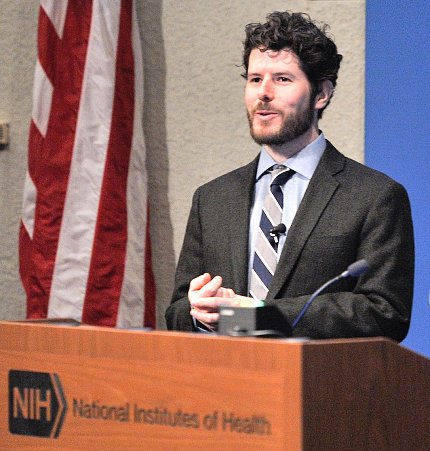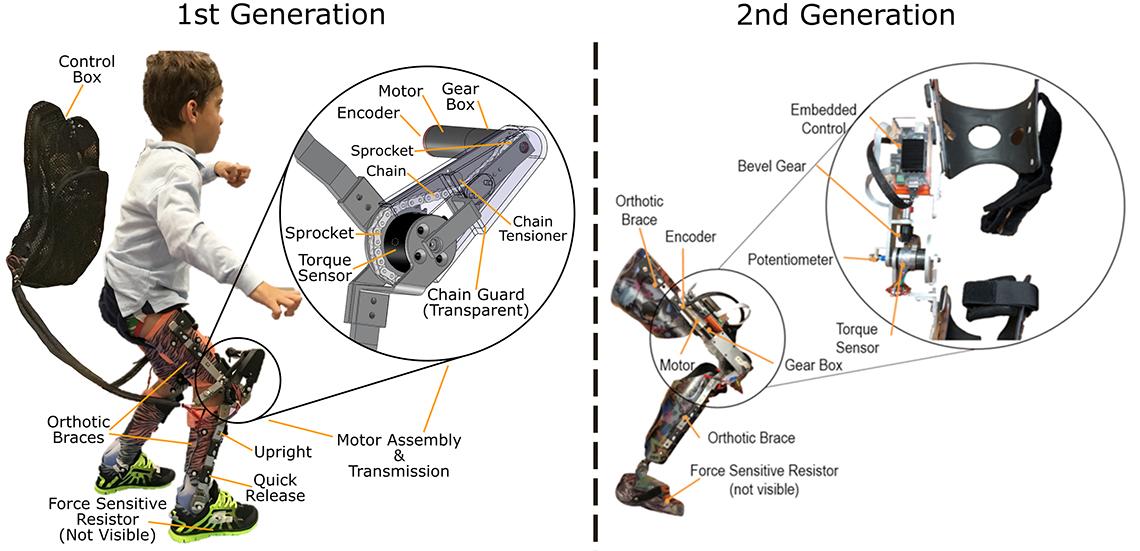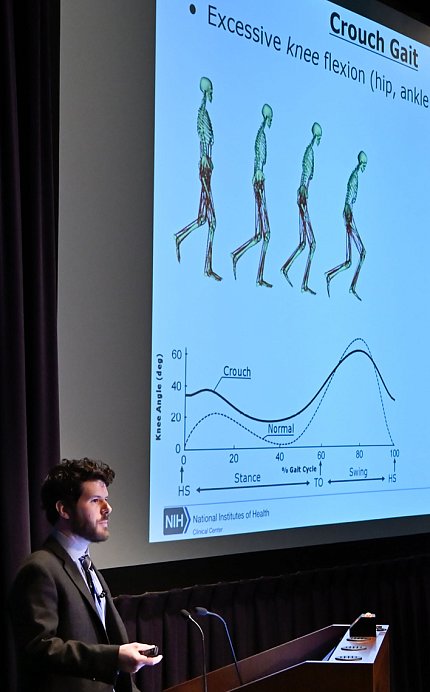Robots + Rehab Training
Can Exoskeletons Help Kids with CP Walk Better?

Photo: Marleen Van Den Neste
For more than a decade now, since 2008 when Marvel Studio’s Iron Man debuted, pop culture fans have been fascinated by the idea of people donning robot parts to be stronger or faster. Medicine and technology teaming up to enhance physical ability is not new, either, with several generations of both theory and application finding success. Until recently, however, one population has been absent from the advances—children.
Enter Dr. Thomas Bulea, an engineer by training and staff scientist in Dr. Diane Damiano’s functional and applied biomechanics section in the Clinical Center rehabilitation medicine department. A few years ago, Bulea led an effort to explore the role of exoskeletons for pediatric patients. He described their progress at a recent CC Grand Rounds lecture, “Robotic Exoskeletons for Improved Walking in Children with Cerebral Palsy.”
First, a short primer on cerebral palsy (CP). CP refers to a group of neurological disorders that stem from damage to or under-developed parts of the brain. It’s usually diagnosed at birth or by age three.
“A hallmark of CP,” Bulea said, “is abnormal motor control due to spasticity and muscle contractures resulting in diminished coordination in both upper and lower extremities.”
A common walking disorder that people with CP experience is crouch gait, characterized by excessive bending of the limb, or flexion, especially at the knee. The hip and ankle may also be involved, and CP can affect one or both sides of the body.

Photo: Thomas Bulea
“Biomechanically,” Bulea explained, “a person with crouch gait walks with one or both knees bent. The leg never straightens completely as in a normal stride, and the limb’s range of motion is limited.”
Crouch gait makes walking a lot more difficult and energy-intensive, he noted.
“Children with crouch have to counteract flexion moments due to gravity with internal moments generated by their own muscles,” Bulea said. “As a result, they have to exert a lot more energy to maintain upright posture than individuals without crouch. Also, the muscles themselves are in a biomechanically less favorable position to extend the limb, so they need to work even harder to provide the necessary extension support.”
It’s a difficult cycle that leads to future problems: Kids with CP have to use more energy to move; muscles therefore become fatigued faster, and that leaves the children less likely to move.
“Studies show that children with CP spend less of their time at high-activity levels, so they’re less active than their typically developing peers,” Bulea explained. “These periods of activity are important for development of children’s muscle strength and coordination. Thus, children with CP do not experience sufficient muscle strength development, especially during periods of rapid growth.”
Consequently, there’s a natural progression (or increase) of crouch gait as kids with CP age.
“Roughly half of children who are ambulatory as adolescents lose the ability to walk in adulthood,” he said.
Treatments for crouch gait vary and come with drawbacks:
- The most popular—and also most invasive—intervention is surgery to lengthen the hamstring and improve knee extension.
- Strengthening via physical therapy often has only short-term effectiveness.
- Botulinum toxin injection to ease overactivity of knee flexor muscles typically wears off after 4 to 6 months.
- Orthotic devices correct posture, but also can worsen weakness over time.
“There really is no effective long-term solution for treatment of crouch gait,” Bulea said.
That’s what prompted the group to pursue robotic-assisted gait training.
“We set out to design an exoskeleton from the ground up specifically for children with cerebral palsy and, even more narrowly, children with crouch gait from cerebral palsy,” he said.
They invented a kid-sized exoskeleton device that helps children walk, but also trains them to walk better on their own.

Photo: Marleen Van Den Neste
“Training has to be both engaging and challenging,” Bulea pointed out. “We like to think of successful rehabilitation as a form of motor learning, and these are key elements. The prevailing approach has been to use an assist-as-needed control strategy whereby the robot adjusts its assistance force based on the volitional action of its user.”
The goal, he said, was to make a device that functions in two ways. First “we wanted to make it a little easier for these kids to walk so that they’ll walk more.” The second goal was to “change the way they use their muscles to walk while they’re wearing it, with the hope that these changes will eventually translate to when they walk without the exoskeleton.”
Unlike assist-as-needed robotic gait training that imposes a predefined trajectory, the user-driven device actually tracks and responds to the user’s own activity, Bulea explained. We wanted to create “a new paradigm for how this robot would interact with children while they are wearing it.”
Adaptation concepts were applied to the device’s design and its assistance features synchronize with the actions of the user.
The group tested the first model of the device in a 6-visit clinical study of 7 male and female young people, ages 5 to 19 years. Although designed simply to test safety and feasibility of the new approach, the study garnered several positive results.
Users’ crouch gait improved in the first session with the device. But perhaps more importantly, performance continued to improve as kids moved through the study. Walking with the exoskeleton significantly reduced asymmetry and over time users walked even better.
What’s more, Bulea reported, the device preserved autonomy. “We saw that the kids were not letting the robot do the work for them.”
Bulea and colleagues have since fine-tuned their design, streamlining several features to make it more compact, portable and less cumbersome.
“We don’t envision that this exoskeleton would be a stand-alone solution,” he said. “We envision it as something clinically that’s used in combination with other treatments.”
Immediate next steps include expanding the user base for the technology, getting it to younger individuals and to populations beyond people with CP such as children with spina bifida, incomplete spinal cord injury or muscular dystrophy.
The group is also working on a tablet-based interface for parents or physical therapists to use with kids and looking into neuro-imaging technology so researchers can see the brain activity that underlies some of the movements users make while wearing the device.
In addition, Bulea and the team have integrated the exoskeleton with other technology to make the rehabilitation/training environment more engaging. Debut of the video gaming—“exer gaming”—application was a hit with both its target audience and some adults as well.
“Exoskeletons allow us to transition gait training out of the clinic and into the community,” Bulea concluded. “That has a lot of powerful implications, with perhaps the most important being the ability to greatly increase the dosage and intensity of training. Rather than coming into a clinic once or twice a week for gait training on a treadmill, children can train for hours a day everyday for months or years.”
